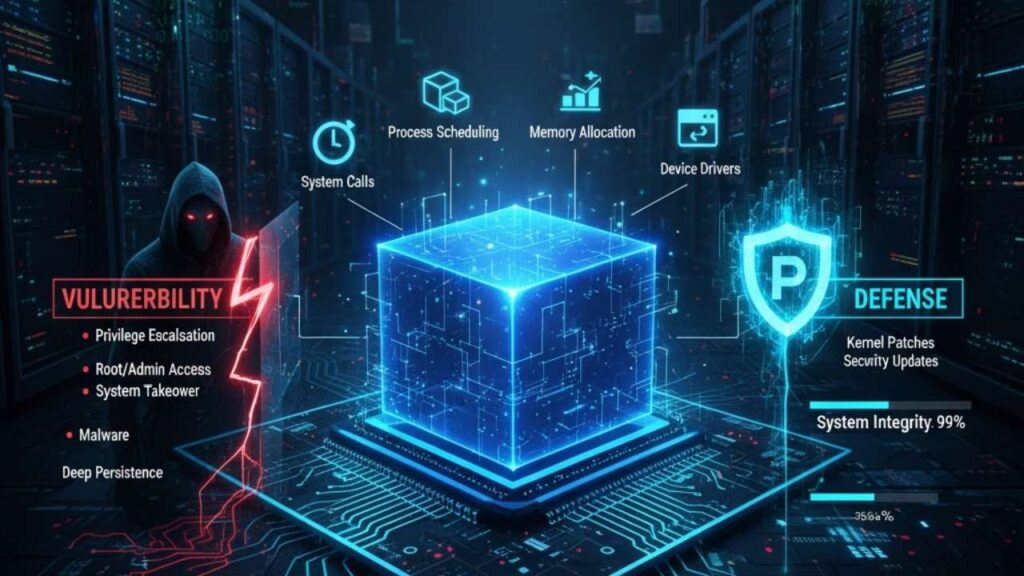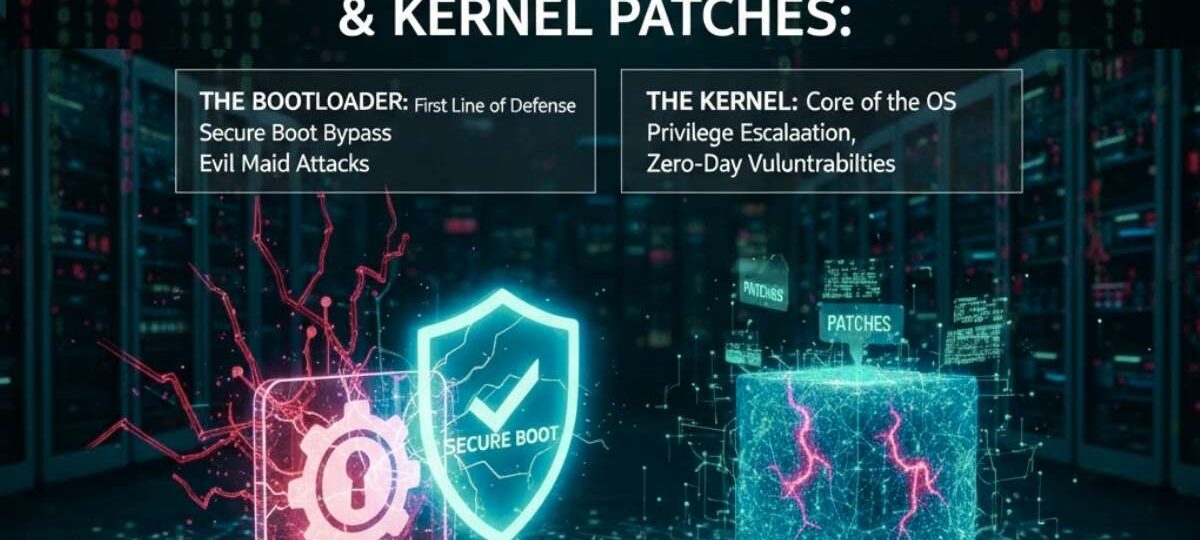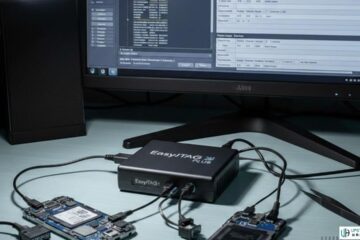In the intricate architecture of modern computing, security is an ongoing, high-stakes battle. At the very foundation of any operating system (OS)—from your smartphone’s firmware to a massive enterprise server—lie two critical components: the bootloader and the kernel. These fundamental layers are the first to execute and manage the system’s resources, making them prime targets for malicious actors. Attacks targeting these components are among the most serious, as they can grant an attacker complete, persistent control over a device. This comprehensive guide delves into the world of bootloader exploits and the essential defense mechanism: kernel patches, exploring the underlying vulnerabilities, exploitation methods, and the continuous effort to secure the digital landscape.
The bootloader is the small, specialized program that initializes the system hardware and loads the kernel. It’s the gatekeeper, deciding what code is allowed to execute during the crucial initial startup phase. A successful bootloader exploit can bypass security checks, load a malicious kernel or OS, and establish an unremovable foothold on the device, often referred to as a rootkit or bootkit. Conversely, the kernel is the core of the OS, responsible for managing hardware resources, memory, and the execution of all applications. Vulnerabilities within the kernel—often privilege escalation or memory corruption flaws—are the cracks in the system’s armor. The countermeasure? Kernel patches, which are critical updates designed to fix these security holes and maintain the system’s integrity. Understanding this interplay is vital for anyone involved in system security, firmware integrity, or cyber defense.
The Bootloader: The System’s First Line of Defense
The entire security chain of a computing system rests on the integrity of the boot process. When a system powers on, the processor executes the firmware (BIOS or, more commonly today, UEFI), which then locates and loads the bootloader (like GRUB, LILO, or Windows Boot Manager). This component’s primary job is to prepare the memory and load the operating system kernel into it, handing over control to it.
A critical modern defense mechanism is Secure Boot, a part of the UEFI standard. Secure Boot establishes a chain of trust by cryptographically verifying the digital signature of every piece of code—including the bootloader and kernel—before it is allowed to execute. If a signature is invalid, the component is blocked, effectively preventing the loading of unauthorized or malicious software.
Anatomy of Bootloader Exploits
Despite the protections offered by Secure Boot, attackers relentlessly search for and exploit vulnerabilities in the bootloader’s complex code. A successful bootloader compromise is often considered an “owning” of the device because the malicious code executes before the operating system and its advanced security features even begin. This is the realm of the firmware rootkit or bootkit.
Common exploitation techniques include:
- Secure Boot Bypass: This is the most sought-after bootloader exploit. A famous example is the BootHole vulnerability (CVE-2020-10713) in the GRUB2 bootloader. This flaw allowed an attacker to modify the
grub.cfgconfiguration file to overflow a buffer in GRUB2, enabling the execution of arbitrary, unsigned code. By leveraging a vulnerability in a component still signed by the trusted keys, the entire chain of trust is broken. - Evil Maid Attacks: These attacks exploit vulnerabilities that require temporary, physical access to the machine. An attacker might tamper with the firmware chip or place a malicious, vulnerable bootloader version onto the boot partition. Since the modified bootloader can load a compromised kernel or disable disk encryption like BitLocker, the attacker gains persistence.
- Vulnerable Signed Binaries: Modern bootkits like BlackLotus exploit older, legitimately signed but vulnerable bootloaders still trusted by the UEFI’s database of allowed signatures. By forcing the system to load one of these vulnerable, yet signed, components, the attacker can then disable security features and establish their own malicious bootloader. Mitigation against this requires adding the hash of the vulnerable component to the UEFI’s Denied Boot Signature Database (DBX), a process that is often slow and complex across the industry.
The Kernel: The Core of the Operating System
If the bootloader is the gatekeeper, the kernel is the central brain of the entire computing environment. It runs in the most privileged mode (Ring-0) and manages everything: process scheduling, memory allocation, device communication via drivers, and handling system calls from user-mode applications.

Because the kernel has absolute control, any vulnerability that allows an attacker to execute code within the kernel context translates to a full privilege escalation—the attacker gains root or Administrator access, effectively taking over the system. This level of compromise allows for deep persistence, surveillance, and control far beyond what user-space malware can achieve.
Kernel Exploits and the Necessity of Patches
Kernel exploits typically leverage sophisticated memory errors or logical flaws. The goal is often to manipulate the kernel’s internal data structures to redirect execution flow or gain read/write access to arbitrary kernel memory.
Key categories of kernel vulnerabilities and exploitation techniques include:
- Buffer Overflows and Use-After-Free (UAF): These classic memory corruption vulnerabilities occur when a program writes more data to a buffer than it can hold, overwriting adjacent memory, or when the kernel attempts to use a memory location that has already been freed and potentially reallocated for another purpose. Exploiting these can lead to arbitrary code execution in the kernel space.
- Race Conditions: These are timing-dependent flaws where the outcome depends on the unpredictable sequence or timing of events. An attacker can use precise timing to manipulate a kernel state between two critical, sequential operations, gaining unauthorized access or privileges.
- Zero-Day Vulnerabilities: These are flaws that are unknown to the software vendor (and thus unpatched) and are actively being exploited by attackers. Zero-day kernel exploits are incredibly valuable on the black market due to their effectiveness against fully updated systems.
The defense against these threats is the kernel patch. The patch development lifecycle involves a rigorous process: a vulnerability is discovered, a fix is developed and tested, and then it is rapidly deployed to users via OS updates. Organizations must adhere to strict patch management policies to minimize the exposure window to known vulnerabilities. The failure to apply a critical kernel patch is one of the most common causes of significant enterprise security breaches.
Mitigation Strategies: The Defender’s Toolkit
The security community has developed a multi-layered defense to make both bootloader and kernel exploitation increasingly difficult.
Bootloader Mitigation:
- Measured Boot and TPM: Technologies like the Trusted Platform Module (TPM) work with Measured Boot to record cryptographic hashes of the boot components—including the firmware and bootloader—into tamper-resistant Platform Configuration Registers (PCRs). These measurements allow remote attestation, proving to a server or user that the system’s boot state has not been tampered with.
- Secure Boot Enforcement: Ensuring Secure Boot is correctly configured and that the DBX list is constantly updated is paramount to prevent the use of known-vulnerable, yet signed, bootloaders like those exploited by BlackLotus.
Kernel Mitigation:
Kernel Address Space Layout Randomization (KASLR): This is one of the most effective mitigations against memory corruption attacks. KASLR randomizes the memory location where the kernel is loaded at boot time. This makes classic exploits that rely on hardcoded memory addresses highly unreliable, as the attacker can no longer reliably predict the location of essential functions or gadgets needed for a successful attack.
Non-Executable (NX) Bit: Also known as Data Execution Prevention (DEP), this hardware feature marks certain memory pages (like the stack or heap) as non-executable. This prevents attackers from injecting and executing their own malicious code in data-only memory regions, forcing them to use complex techniques like Return-Oriented Programming (ROP).
Kernel Hardening: Techniques like Kernel Lockdown in Linux restrict kernel functions and interfaces, preventing applications from changing kernel runtime behavior even if a minor vulnerability is found.
Conclusion: The Continuous Security Arms Race
The security battle at the system’s foundational layers is a perpetual arms race. Bootloader exploits, particularly those bypassing Secure Boot or establishing persistent bootkits, represent the deepest level of system compromise, demanding constant vigilance. Simultaneously, the sophisticated techniques used in kernel exploitation—from memory corruption to timing attacks—necessitate immediate and meticulous deployment of kernel patches and security features like KASLR and Measured Boot.
For system administrators and security professionals, maintaining firmware integrity, ensuring robust patch management, and understanding the underlying security architecture of their systems are non-negotiable responsibilities. As attackers continue to evolve, the future of OS security will likely focus on even more advanced defense paradigms, such as immutable systems and formal verification, to guarantee that the digital foundation remains trustworthy from the very first instruction. The diligence of applying that latest kernel patch is not merely good practice; it is the essential act of maintaining digital sovereignty.
See Also: Network Firewall and Security Features on the Router to Protect Against Hackers










